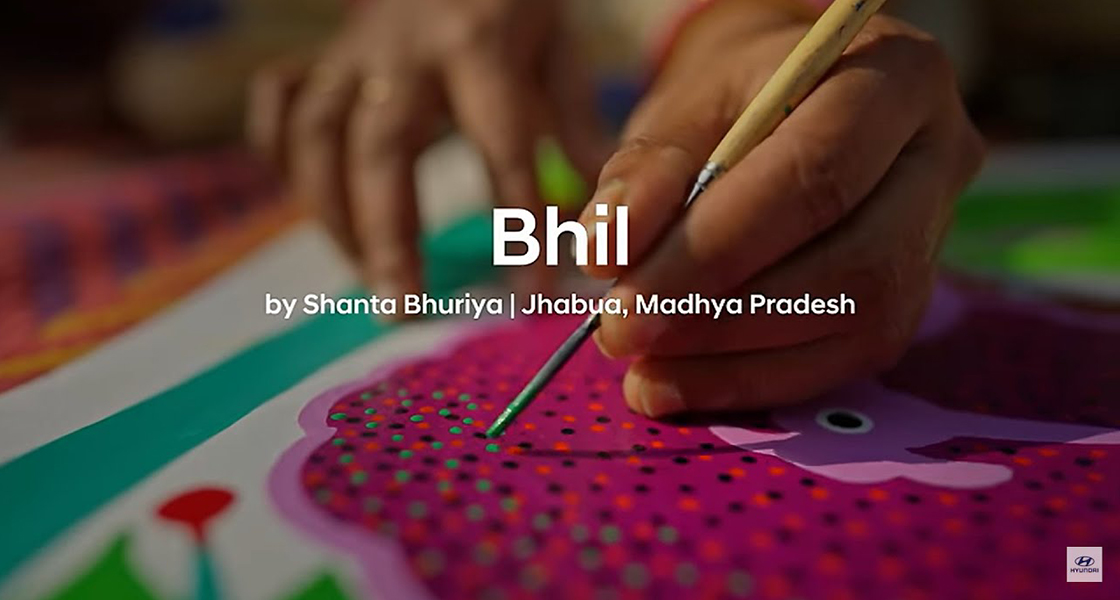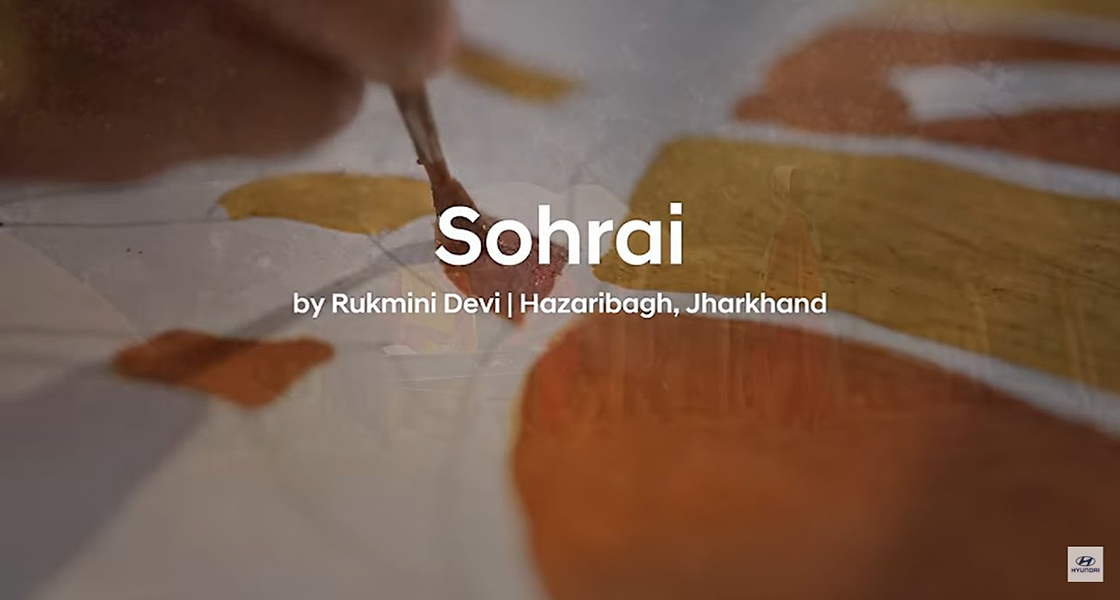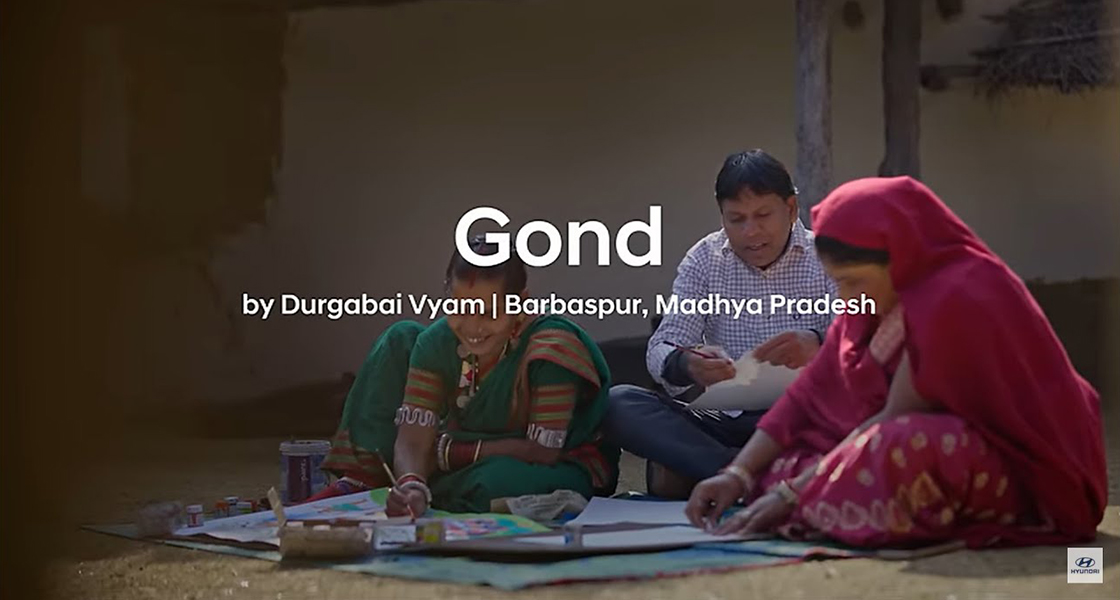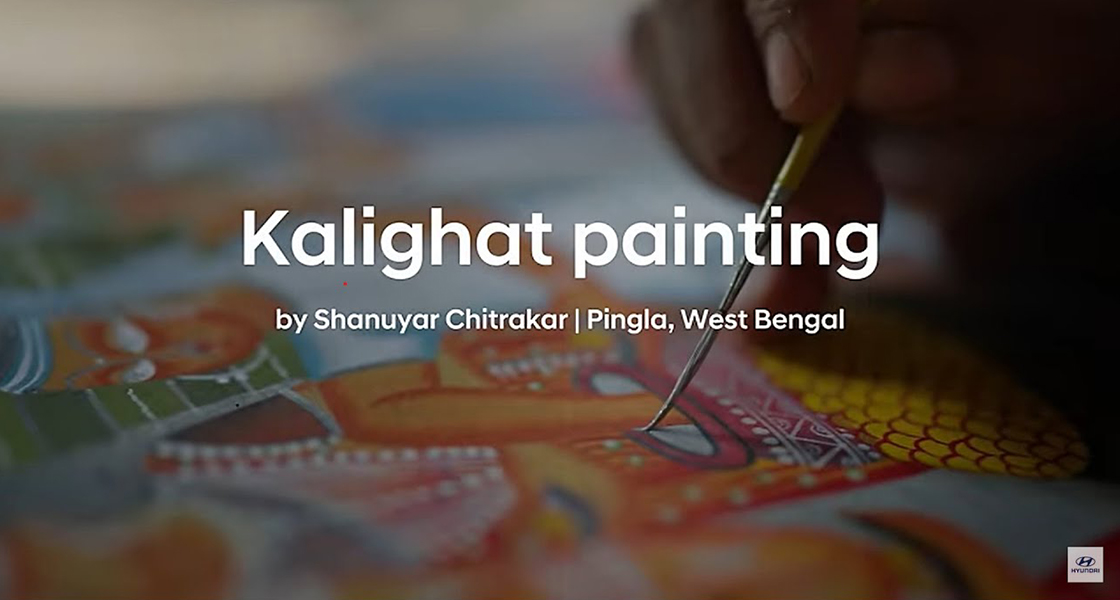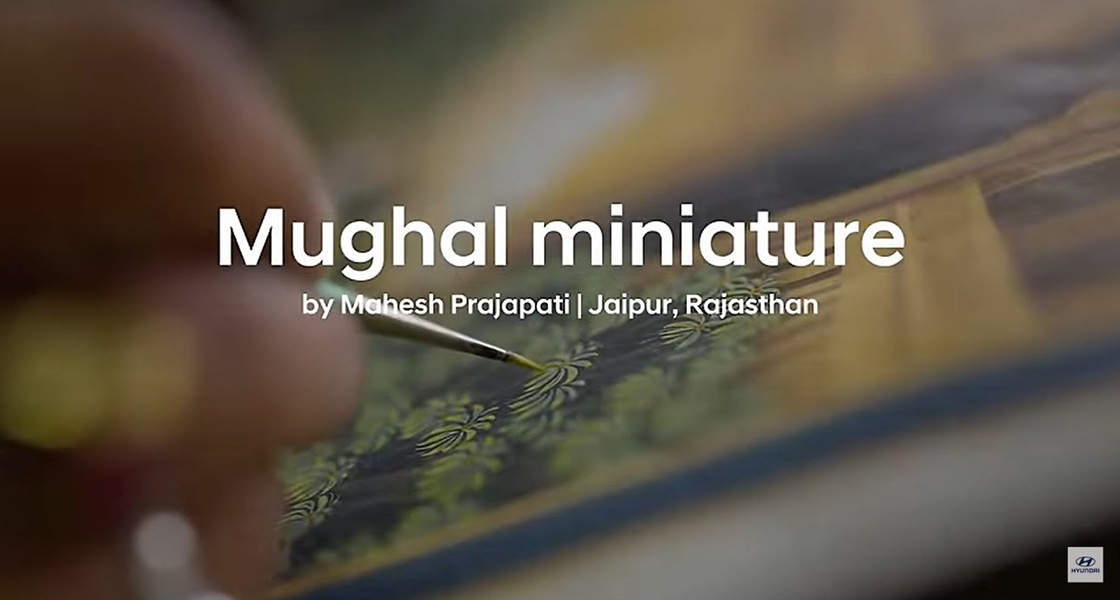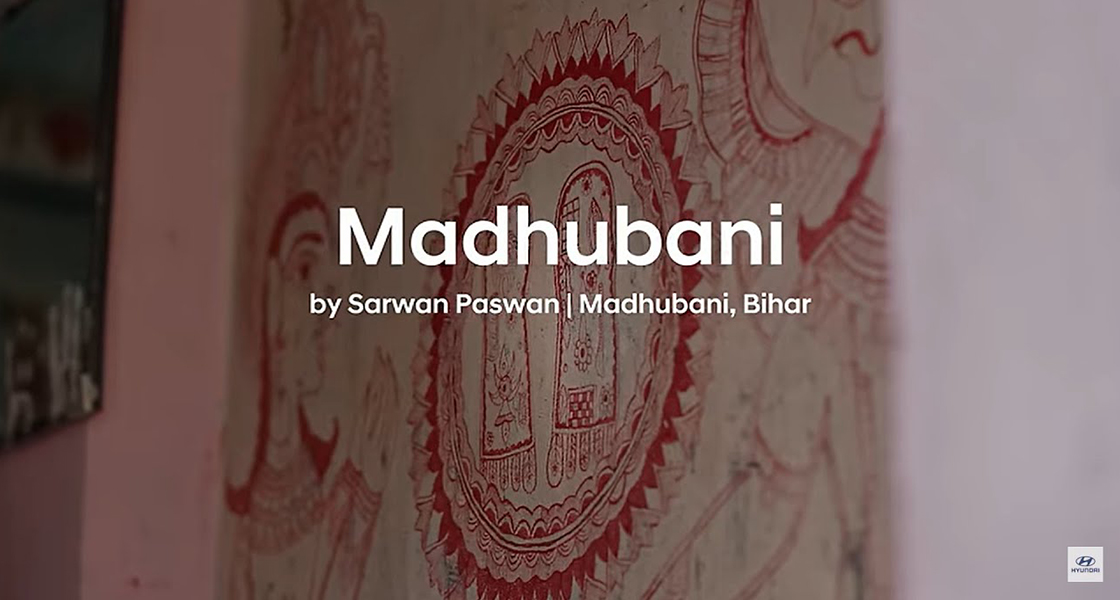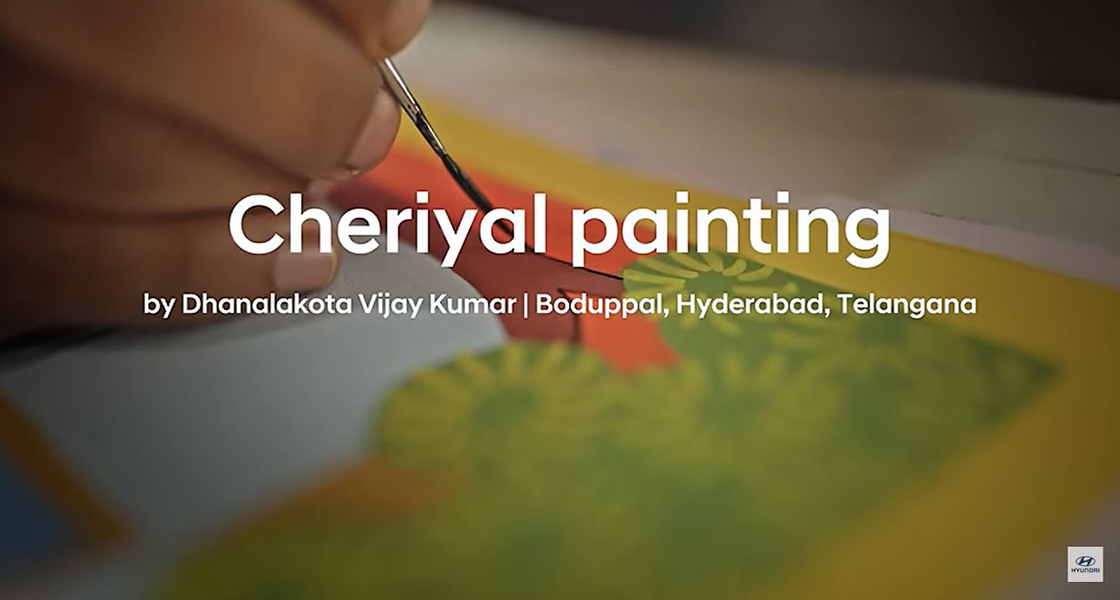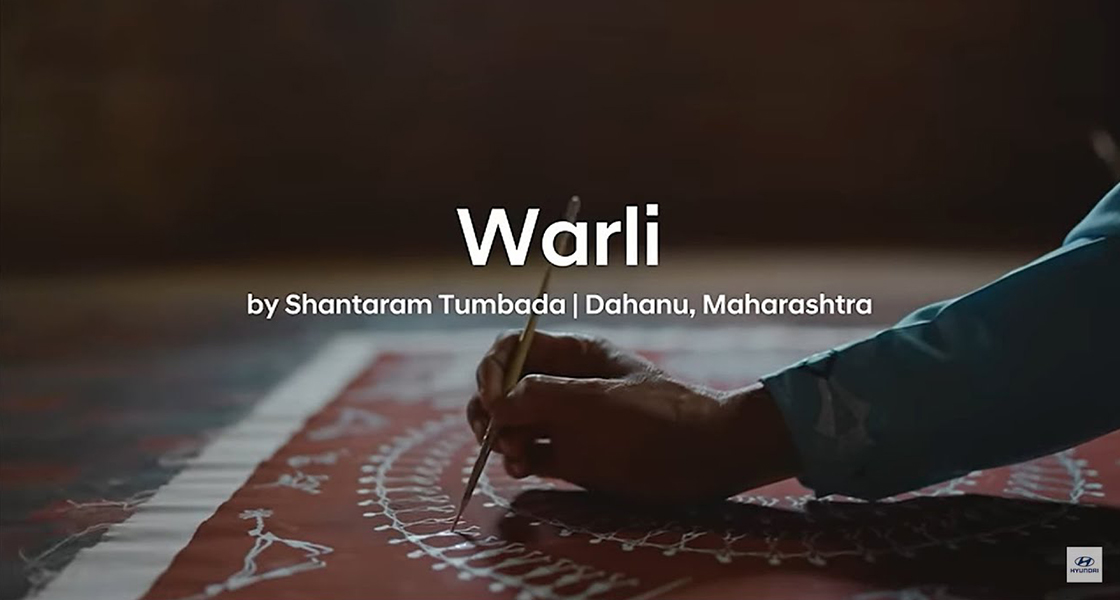A journey through artscapes
From selling its first car in India almost 26 years back, Hyundai has now become an integral part of India. Across its length and breadth, from its farthest corners to the nearest, a car is a part of India’s aspirations, journeys, and everyday life. What better way to celebrate this than to weave cars into something that is equally Indian - the many art forms of India, each with its own uniqueness yet bound together by the land they all come from. You are about to embark on a journey that takes you closer to the richness and diversity of India. Through the works of 12 artists from across India, who have made the cars part of their stories, folklores, landscapes, lives, and more.
January
‘Life lies beyond’ in Bhil Art | Bhopal, Madhya Pradesh
The Bhils, native to Western and Central India, are India’s second largest tribal community. Their instantly recognisable art form is characterised by dots and vibrant colours. Having started out as hunters and archers, the theme of their art depicts everything from their lives - people, animals, trees, insects and even various rituals, events and festivities. Originating as ritualistic frescoes for walls and ceilings, Bhil art can now be found across multiple mediums and materials.
February
‘Weekends are never far’ in Pichwai | Nathdwara, Rajasthan
Pichwai is a style of painting that originated over 400 years ago in the town of Nathdwara in Rajasthan. The literal meaning of the word is ‘that which hangs from the back’ and is as such designed as wall hangings. Visually stunning, intricate in detail and lush with colours, Pichwai paintings typically depict tales from Lord Krishna’s life. Besides other subjects like Radha, gopis, cows and lotuses, frequently depicted are festivals and celebrations such as Raas Leela and Holi.
March
‘There’s more out there’ in Sohrai Painting | Hazaribagh, Jharkhand
Sohrai painting is a form of tribal art that is practiced in and around the villages of Hazaribagh district in the Indian state of Jharkhand. The art is related to the festival of Sohrai, which is celebrated during the months of autumn after Diwali. This art form is passed on from mothers to daughters, with the mother-child bond being one of the key topics covered. It is also known widely for its depiction of creatures, as well as the trademark red and black lines that have come to characterise this art form.
April
‘Tomorrow is beautiful’ in Kerala Mural | Iringul, Kerala
Kerala mural paintings are frescoes that depict Hindu mythology in the ancient temples and palaces across the Indian state of Kerala. It is characterised by the use of five main colours: white, black, yellow, green and red. Having gained popularity between the 9th and 12th centuries when it enjoyed royal patronage, Kerala mural paintings went through an extended period of neglect. Post independence, the art has had a resurgence of sorts, with artists and families reviving the form.
May
‘Celebrating extravaganza’ in Kalamkari | Srikalahasti, Andhra Pradesh
Kalamkari is a textile-based traditional Indian art form that originated in the present-day states of Andhra Pradesh and Telangana. There are two distinct types of Kalamkari: the ‘Machilipatnam’ style, which involves block-printing and the ‘Srikalahasti’ style, which involves free hand drawing. The traditional way of creating a Kalamkari artwork involves 23 meticulous steps, involving everything from preparing the fabric, making the natural pigments, to application and fixing of colours.
June
‘Back to nature’ in Gond Art | Bhopal, Madhya Pradesh
The Gonds are among central India’s largest indigenous communities. The Pardhan Gonds, a subsect of the Gonds, were responsible for perpetuating the collective memory of virtues and stories of valour of Gond kings in return of royal patronage. The late painter J. Swaminathan discovered the pioneering Gond artist Jangarh Singh Shyam decorating huts of Patangarh in Madhya Pradesh and introduced the fine lines, dots and dashes of Jangarh to the world, which gives the art form its distinctive look.
July
‘The many tastes of life’ in Kalighat Painting | Pingla, West Bengal
Kalighat painting is a school of painting that originated in the vicinity of the Kalighat Kali Temple in Kolkata, the capital of the state of West Bengal. The art form had originated as souvenir items for visitors and devotees who came to the Kalighat Kali Temple, where these works often depicted the many gods, goddesses, and scenes from the Indian epics and mythology. As the popularity of this art form spread, scenes from everyday life were brought into the fold as well.
August
‘Take luxury along’ in Mughal Miniature | Jaipur, Rajasthan
Mughal miniature is a very distinctive style of painting that emerged from Persian miniatures. Over time, it found the right environment and patronage in the courts of the Mughal empire, where it blossomed and flourished from the 16th to 18th century and later spread to other courts of North India as well. Apart from depicting royal life and scenes from the court, these miniatures also featured other themes and subjects such as battles, hunting scenes, wildlife and mythology.
September
‘Room for families’ in Madhubani Painting | Madhubani, Bihar
Madhubani art, also known as Mithila art, is a rich tradition of domestic ritual painting that takes its name from the region in northern Bihar where it began and continues to thrive. Historically, women made Madhubani paintings on the freshly plastered walls and floors of mud huts. These skills and techniques were passed down for centuries, preserving Madhubani’s unique qualities and techniques. Today, both men and women paint in this style on clothes, handmade papers and canvases.
October
‘Every day is awesome’ in Cheriyal Scroll | Boduppal, Telangana
Cheriyal painting is a type of scroll painting prevalent in the Southern Indian state of Telangana. These paintings were mostly confined to Cheriyal village, and hence called Cheriyal scrolls. The scrolls often depict themes and stories drawn from ancient literary, mythological and folk traditions that are interspersed with scenes depicting rural life. The costumes, settings and iconography are strongly influenced by local tastes and sensibilities, allowing for a very distinctive style of storytelling.
November
‘The making of a journey’ in Kurumba Painting | Valerikombai, Tamil Nadu
Kurumba painting is one of India’s lesser-known art forms that originated in the Nilgiris. Considered to be at least 3000 years old, it is practiced by the Kurumba tribe and is a chronicle of their deities, rituals and way of life in the midst of nature. Working with simple shapes and motifs that are geometric in nature, Kurumba paintings stand apart due to their minimal colour palette featuring red, white, black, and green, derived from natural sources like soil, sap, barks and leaves of trees.
December
‘To new beginnings’ in Warli Painting | Dahanu, Maharashtra
Pioneered by the Warli tribe, located on the outskirts of Mumbai, these paintings use a set of basic geometric shapes that are symbolic of different elements of nature: circles, triangles and squares. The circle represents the sun and the moon, while the triangle depicts mountains and conical trees.
The central motif in each ritual painting is the wedding ceremonial square, known as the "chok" or "chokhat". Starting off as wall paintings, Warli has moved on to paper and canvas in recent times.
To download the Calendar 2024 click here



